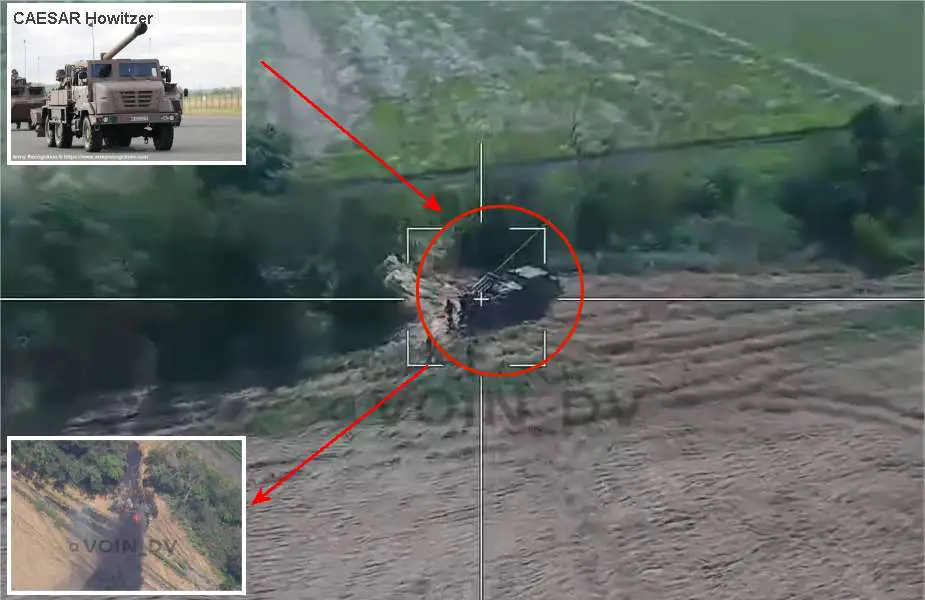Second Ukrainian CAESAR Howitzer Destroyed by Russian Lancet Kamikaze Drone
A video published on the "Ukraine Weapons Tracker" Twitter account on August 26, 2023, revealed that Russian armed forces have destroyed a second CAESAR 6x6 155mm self-propelled howitzer using a Lancet loitering munition near Veselyi Hai, Donetsk Oblast. This marks the second confirmed destruction of a CAESAR howitzer out of the 30 that have been delivered by France to Ukraine since May 2022.
Follow Army Recognition on Google News at this link

Russian forces have destroyed a second Ukrainian CAESAR 155mm 6x6 self-propelled howitzer donated by France. (Picture source Screen Shot Twitter Video)
France has been a significant contributor to Ukraine's military arsenal since the onset of the conflict. Alongside the 30 CAESAR 6x6 self-propelled howitzers, France has also supplied tens of thousands of shells, including LU 211 HE shells, BONUS munitions, and Ralec proximity fuzes. However, the recent destruction of the second CAESAR howitzer raises questions about the effectiveness and survivability of these systems in the ongoing conflict.
Citing open source information, the Ukrainian army has lost four CAESAR howitzers in total—two destroyed and two damaged. These losses could potentially impact the Ukrainian army's artillery capabilities, which rely heavily on the CAESAR systems for long-range fire support.
The CAESAR (CAmion Équipé d'un Système d'ARtillerie) is a 6x6 wheeled self-propelled howitzer that features a 155mm/52-caliber gun with a firing range of up to 40 km using Extended Range Full Bore (ERFB) base bleed shells. The system is highly mobile, capable of reaching speeds of up to 100 km/h on roads, and can be rapidly deployed, requiring less than six minutes to set up and fire and only two minutes to scoot to a new position.
In terms of ammunition, the CAESAR is versatile, and compatible with a variety of shells including LU 211 HE shells, BONUS smart munitions, and Ralec proximity fuzes. Its automated loading system allows for a sustained firing rate of 5-6 rounds per minute, making it a formidable asset for long-range fire support in both conventional and asymmetric warfare scenarios.
The Lancet loitering munition used in the attack is a type of drone that can loiter over a target area and strike when a target is identified. Its successful use against a CAESAR howitzer indicates an evolving battlefield where traditional artillery systems may be increasingly vulnerable to new forms of aerial attack.
The Lancet loitering munition is a type of unmanned aerial vehicle (UAV) designed to loiter over a battlefield and engage enemy targets. Unlike traditional munitions that follow a predetermined trajectory, the Lancet can be remotely controlled, allowing it to search for targets and strike with precision. Equipped with real-time video and data transmission, it provides operators with the ability to make informed decisions before launching an attack.
The Lancet loitering munition is equipped with a warhead, designed for precision strikes against enemy targets. It has the capability to loiter over a target area for an extended period, usually up to several hours, providing real-time video and data transmission to its operators. With a range that can extend to several tens of kilometers, the Lancet can be remotely controlled to search for and engage targets. Once a target is identified, the munition can be directed to strike with high accuracy, making it effective against both stationary and moving targets, including armored vehicles and artillery systems.
In the context of the war in Ukraine, the Lancet has proven to be a game-changer, particularly against traditional artillery systems like the CAESAR howitzers. Its ability to loiter and strike with high accuracy makes it a potent tool for neutralizing key assets of the Ukrainian army. The recent destruction of a second CAESAR howitzer by a Lancet loitering munition near Veselyi Hai, Donetsk Oblast, underscores its impact. This incident not only highlights the vulnerabilities of traditional artillery systems but also forces a reevaluation of the types of weapons that should be deployed in modern conflict zones, where aerial threats like loitering munitions are increasingly prevalent.
Traditional artillery systems like the CAESAR howitzer are designed primarily for long-range fire support and are not inherently equipped to defend against aerial threats like loitering munitions. Loitering munitions such as the Lancet possess the ability to hover over a battlefield, providing real-time surveillance before striking, which allows them to easily locate and target artillery positions. Unlike fast-moving aircraft or missiles, their loitering capability makes them difficult to detect and intercept in time, thereby exploiting a significant vulnerability in traditional artillery systems.
The artillery units are often exposed while setting up, firing, and relocating, making them susceptible to precision strikes from loitering munitions. The recent incidents in Ukraine, where CAESAR howitzers were destroyed by Lancet loitering munitions, highlight this vulnerability and indicate a need for integrated air defense systems or counter-UAV measures to protect these valuable artillery assets.
As the conflict in Ukraine continues to evolve, the destruction of a second CAESAR howitzer serves as a stark reminder of the changing dynamics of modern warfare. It also puts a spotlight on the arms being supplied by international allies, prompting questions about their effectiveness and adaptability in the face of new and emerging threats

Since the beginning of the war in Ukraine, France has donated 30 CAESAR 155mm 6x6 self-propelled howitzers to Ukrainian armed forces. (Picture source Army Recognition)
News Russia Ukraine War























